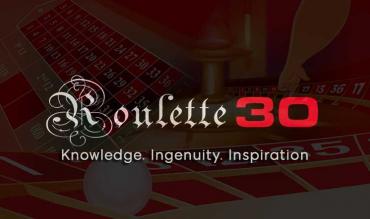We’ve all seen the famous movie cliché. A high roller puts his whole stack of chips on a number picked on a hunch on a roulette table. The croupier sets the ball rolling, calls “no more bets” and, after a few tense turns around the roulette wheel, the ball lands with a satisfying “plunk” in the gambler’s choice of number.
But, as anyone who knows anything about roulette will tell you, the chances of this actually being reality are, at best, 37 to 1 – not good odds by anyone’s reckoning. The assumptions behind this scenario are also as inaccurate as the likelihood of it actually happening, namely that roulette is purely a game of luck that leaves you at the mercy of the wheel.
The first important decision you have to make is to carefully choose the kind of roulette you’re going to play. There’s the choice of American, European and French versions of roulette. The former has both the numbers ‘0’ and ‘00’ as well as 1 to 36, making 38 possible places where the ball could land. On the other hand, European roulette doesn’t have the additional ‘00’ so there are just 37 possibilities. The difference may sound marginal but it’s certainly something to be considered. The French version is the most rare, yet the more favorable to player.
Start to play roulette and you’ll soon discover that one of the real beauties of the game is the wide range of betting options it offers you. For example beyond the simple choice of red or black you can also bet on groups of twelve numbers – 1-12, 13-24 or 25-36 – which will reward you for a win at 2 to 1 or even on four numbers in a block on the table that pays out at 8 to1. So, as you can see, there are options to appeal to both the cautious and more adventurous gambler.
Throughout its history players, and even scientists, have been trying to devise fool proof systems to beat the wheel and whether they’ve succeeded because of – or despite – their strategies is always open to debate. Nevertheless, here’s a rundown of seven of the most commonly used ones.
The Martingale
Probably the best known of all betting strategies, and one which is particularly suited to situations where there is approximately a 50/50 chance of winning, for example by betting on red or black, odds or even, the theory is simple. The idea is that each time you lose a bet the next time you double your stake. As you’re bound to win eventually, it will eliminate all of your losses and leave you with a big win. While this is logically true, practically it’s going to need a potentially infinite bankroll to succeed. That’s because very quickly the stakes can rise – say you bet $5 to begin with, after five unsuccessful bets this rises to $80 a spin and after ten to $2,560. So if you’re going to use it at all it’s best to wait for the first big win and then withdraw.
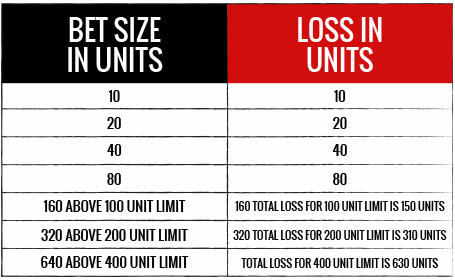
Labouchère
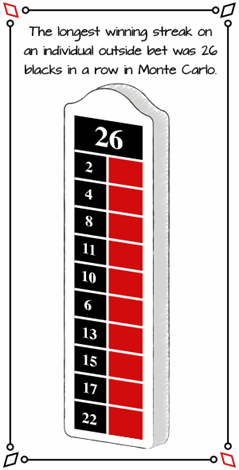 Known as a cancellation method, the Labouchère is a system that is simple to carry out and which can be effective way to play 50/50 bets. You start by deciding how much you want to win and convert it into units. Say it’s $100 or ten units of $10 each. You then write a sequence of units that add up to 10, say 1, 2, 3, 2, 2. For your first stake take the first and third numbers in the sequence, so 1 and 2, or $30. If you win, cross the numbers out on the sequence, if you lose you then you have to add a 3 to the end of your sequence and play again. Once you’ve crossed out all the numbers you’ll know that you’ve reached your original winning goal of $100. A big advantage of this method is that you can bear losses on your way to winning and, although the stakes can rise, it won’t be nearly as quickly as in the martingale.
Known as a cancellation method, the Labouchère is a system that is simple to carry out and which can be effective way to play 50/50 bets. You start by deciding how much you want to win and convert it into units. Say it’s $100 or ten units of $10 each. You then write a sequence of units that add up to 10, say 1, 2, 3, 2, 2. For your first stake take the first and third numbers in the sequence, so 1 and 2, or $30. If you win, cross the numbers out on the sequence, if you lose you then you have to add a 3 to the end of your sequence and play again. Once you’ve crossed out all the numbers you’ll know that you’ve reached your original winning goal of $100. A big advantage of this method is that you can bear losses on your way to winning and, although the stakes can rise, it won’t be nearly as quickly as in the martingale.
D’Alembert
Invented in the 18th century by the French roulette expert Jean le Rond D’Alembert, this is similar to the martingale but has a far flatter rise in stakes. Again, best used for 50/50 bets, the theory suggests that after each loss you increase your stake by just one chip. This prevents you from suddenly finding yourself betting huge amounts on a spin of the wheel but, equally, it will mean that recovering from losses will be a slower process. There is also a strategy called the Contre D’Alembert in which you increase your stake by one chip each time you win and keep the level each time you lose.
The Parlay System
The Parlay is an accumulator system that can be used effectively in almost any kind of betting and is a relatively safe way to play over the short term at least. The basic theory is that the player begins by deciding on a maximal win, say $200. Then they start playing and each time they win they place both stake and winnings on the next bet until they reach their maximal projected win. At this point they can choose to quit the game or begin it all over again. The advantage of this approach is that it allows for different kinds of bets while limiting risk. To ensure this, it’s important that the maximal win should be achievable after a maximum sequence of four winning bets and in this way the player’s bankroll will never come under too much pressure.
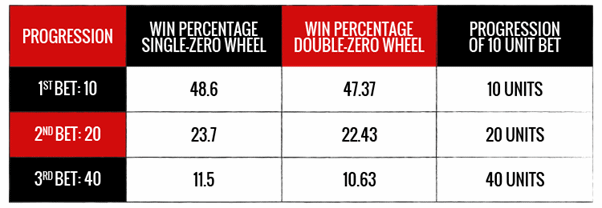
Fibonacci
Fibonacci is a well-known number sequence found in nature in which progression occurs by adding the two previous numbers to make a third – typically 1,2,3,5,8,13,21,34 etc. By using this progression it can give guidance as to what the stake should increase to after each loss. Then, after a win, the player can either go back a step – say they reached a stage where the stake was13 units, the next would be 8 – or go right back to the beginning. But, like the martingale, there’s a very real danger of stakes quickly becoming unsustainable or way above the table limit.
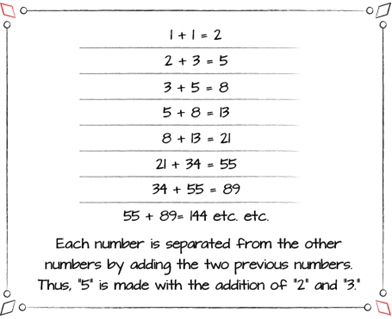
Kavouras Strategy
While most of the previous strategies have been in use for many years, it’s believed that the Kavouras strategy was devised as recently as 2010. Unlike the others, it’s more dependent on using a fixed combination of best to ensure a better than evens chance of winning. Using 8 separate bets, it divides as follows:
One should be placed on the corner covering the numbers 0, 1, 2, 3. Two should be placed on the double street covering the numbers 31, 32, 33, 34, 35, 36. One should be placed on each of the following five splits: 8/11, 13/14, 15/18, 17/20, 27/30.
This covers a total of 20 numbers in all, more than half of the ones on the wheel giving you a better than evens chance of a win on each spin of the wheel. What it can’t affect is the house edge so, however successful it may be in the short term, the house will always come out on top in the end. Nevertheless, it’s a different and exciting strategy to use.
Oscar’s Grind
Last but not least, there’s Oscar’s Grind. This is very similar to the D’Alembert system but with an additional safety measure built in. Once again, each time you lose you up your stake by one unit, but each time you find that you’ve won a unit’s profit you go back to the start again. By splitting your play into such small segments your bank roll won’t be under any pressure and you could well be making steady, if unspectacular, progress. The worst that can happen is a long losing streak. If this happens, the easiest thing is to walk away and come back another day when luck’s more on your side.
All of these strategies have their fans, including players who will have claimed to have big money wins with them – although most are, quite understandably, reluctant to go into much detail with them.
These strategies are also employed by players in online casinos too, where the maths and probabilities are very much the same – even if the environment isn’t. You can communicate with glamorous live dealers and other players while you spin the wheel, you can enjoy all the thrills of this classic game through playing live roulette at 888casino, a leading online casino brand. There’s also a great range of games to play with table limits that make them perfect for all levels of player.
Whether the strategies discussed here will help you to win remains to be seen. Or you could just work on a hunch, which certainly did the trick for Sean Connery back in 1963. The actor reportedly bet on the number 17 three times in a row in a casino in the Italian Alps, and it came up every single time, winning him 17 million lire. Proof, if any were needed, that for all the strategies in the world, relying on simple luck may well be your best bet whenever you take to the roulette table.
